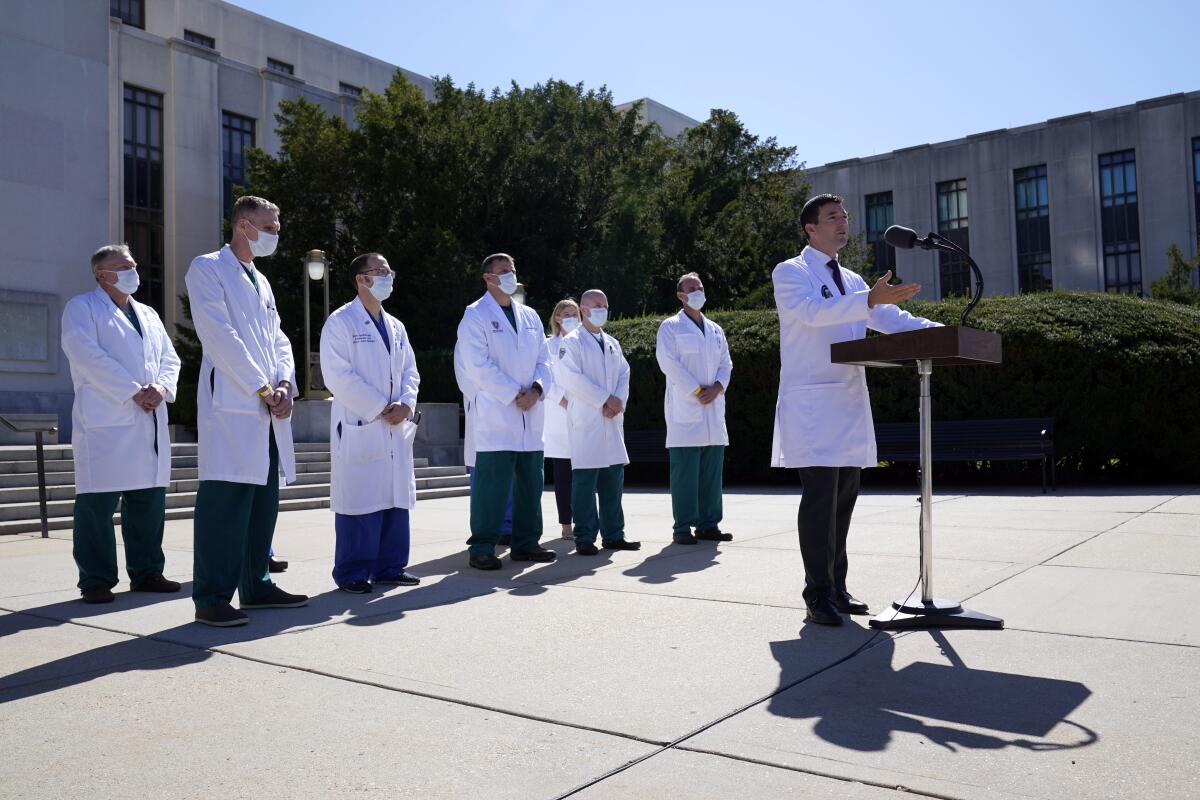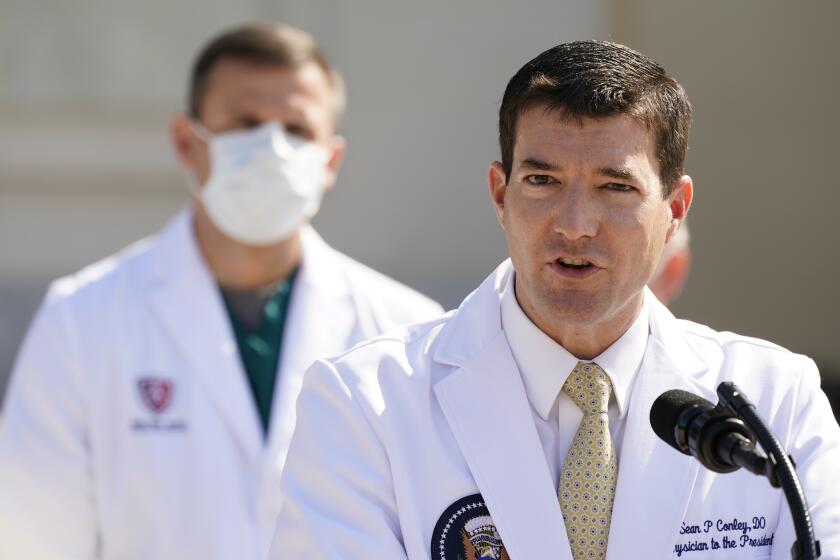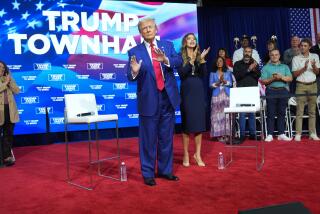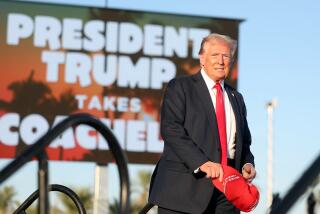News Analysis: A history of falsehoods comes back to haunt the COVID-stricken president

- Share via
Donald Trump’s presidency began with a falsehood, and now, thousands of misstatements later, that history of prevarication is undermining the administration at a time when trust is needed most.
As the president continued to suffer the effects of COVID-19 — the true extent of his ailment and condition being two of many unanswered questions — the news media and the country it serves were lost Saturday in a fog of contradiction and misinformation.
Doctors treating Trump’s COVID-19 say his oxygen levels fluctuated and that they’ve prescribed dexamethasone, a steroid, amid signs of lung damage.
It was nothing new. As of this summer, the Washington Post’s Fact Checker tallied more than 20,000 false or misleading claims made by the president since assuming office — a major reason he’s struggling for reelection. But that made the obfuscation no less fraught.
“There are moments in which the president and the office of the presidency and the White House in general need to be trusted, because the country needs to know that we have a president who is capable of discharging the functions of the office,” said Kathleen Hall Jamieson, a political communications expert at the University of Pennsylvania.
“If that trust doesn’t exist,” she said, “we cannot trust the statements that reassure he’s in fact capable of discharging his duties.”
Kevin Madden, a communications strategist with experience on Capitol Hill and serving three Republican presidential campaigns, was blunter still. “The chickens,” he said, “are coming home to roost.”
This was not, however, the harmless and easily disprovable claim that Trump’s inaugural crowd size surpassed any in history. Rather, it was a literal life-and-death matter involving a virus that has killed more than 209,000 Americans and now infects the president of the United States and many powerful people in his Republican Party.
Watching Saturday’s briefing by a phalanx of white-coated doctors gave Dr. Robert Wachter, chair of the department of medicine at UC San Francisco, what he called “CDC déjà vu” — a reference to the way Trump and others in the administration have consistently undercut the federal Centers for Disease Control and Prevention in hopes of putting the best gloss on the global health crisis.
“Here is a previously trusted institution, a physician talking about the president, who is engaged in total spin,” Wachter said of Dr. Sean Conley, Trump’s personal physician, who soon after the briefing had to clarify the evasive and overly rosy statements he made to reporters.
“People make mistakes. That happens,” Wachter said. “But not in situations where you are about to speak to the world about the status of the president. It makes them look like the gang that couldn’t shoot straight.”
Judd Deere, the administration’s deputy press secretary, said, “The White House is fully committed to providing transparent and regular updates on the president’s condition and recovery.”
Trump and his team are not alone in withholding pertinent health information.
President Cleveland had clandestine surgery on a yacht to remove a cancerous growth in his mouth. Franklin D. Roosevelt hid outward signs of his paralysis from polio and never disclosed the poor health conditions that led to his death early in his fourth term. When Ronald Reagan was shot in an assassination attempt in 1981, the White House hid how close he came to dying.
But Trump stands apart, as he has in so many ways, with his voluminous catalog of falsehoods.
A new timeline from President Trump’s doctors, if accurate, would mean Trump held events while knowing he was sick, potentially exposing supporters, employees and others. The White House quickly tried to walk back some of the comments.
A Gallup survey in June found that only about a third of Americans, 36%, considered the president to be honest and trustworthy. By comparison, a quarter of Americans said that about President Clinton following his impeachment after lying about an affair with a White House intern.
Trump’s pallid rating, to no surprise, reflects a deep partisan divide. Democrats have always given Trump rock-bottom ratings in contrast to the much more favorable views of Republicans. But even some within the GOP have grown dubious of their party leader. In 2017, more than 8 in 10 Republicans thought Trump was trustworthy; three years later, that number fell to just about 7 in 10.
The truth deficit has steepened Trump’s climb to reelection.
“As a general rule, trust precedes everything,” said David Paleologos, a pollster at Suffolk University, whose surveys have also found a presidential credibility gap. “If people jump off the trust bandwagon, then the unfavorable ratings go up.”
Joe Biden has unabashedly leaned into the trust issue.
“Everything he’s saying so far is a lie,” the exasperated Democratic nominee said during last week’s roughhouse presidential debate. “Everyone knows he’s a liar.”
Normally, using the L-word is akin to rolling a grenade in the middle of a campaign. Not so with this president, said John Anzalone, a Biden pollster. “We have an opponent who the American public thinks is dishonest and believes is a liar,” he said. “It’s fair game to use that word.”
Anzalone emphasized that he was not speaking specifically to Trump’s medical briefings — the Biden campaign has been delicate in how it speaks about the president in this moment of urgency, even taking down its negative television ads. But Anzalone said he doubts the public’s trust in Trump will change much in the month before election day.
“This has also been a trait built over a lifetime of Donald Trump and particularly over the last four years,” Anzalone said.
A spokesman for Trump’s campaign, Ken Farnaso, suggested reporters have waged a relentless campaign to tear the president down, contributing to his negative approval ratings.
“The media will truly never understand the unique bond President Trump has with everyday Americans,” Farnaso said. “The blatant bias and endless attempts to manipulate reality, like we saw with the two-year Russia hoax, proves it is essential for the president to bypass the media and talk directly to the American people.”
In conservative Placer County, Trump supporters say they are disheartened by liberals’ apparent glee after Trump tests positive for COVID-19. Liberals say he had it coming.
Before he became the leader of the free world, Trump was a brash New York City real estate developer who gleefully trafficked in exaggeration, or outright baloney, to sell his properties and, not incidentally, himself. “Truthful hyperbole,” he called it, ignoring the contradiction.
It all seemed good fun at the time.
“Back in the old days, when he exaggerated his wealth by two or three times, nobody made a big deal about it, or his escapades posing as a press spokesman spreading the word about all the beautiful women who were chasing Donald Trump,” said Michael D’Antonio, a Trump biographer. “Lying never mattered, and telling the truth wasn’t a requirement. All that was required was that he be colorful and quotable.”
Although the stakes changed, growing vastly more important once he took office, Trump did not, D’Antonio said.
When it came to his health, Trump raised eyebrows in 2015 by releasing a letter from his doctor brimming with over-the-top praise. In November, he made an unexplained visit to Walter Reed National Military Medical Center, which his physician, Conley, vaguely described as an “interim checkup.”
Now that opacity is undermining the White House’s ability to allay concerns about Trump’s health and lay to rest doubts about the veracity of his medical team.
“There have been ample warnings that lack of credibility at the White House would cost us,” said Mike McCurry, who served as a press secretary in the Clinton administration. “Now we see it. We don’t believe anything we hear about the president’s health and don’t trust anyone there to tell the truth.”
For years, Trump has sought to undermine the media as purveyors of “fake news.” Now he is relying on many of the same outlets to assure unsettled Americans that the country’s leader is spry and swiftly on the mend.
Instead, Saturday’s news reports were filled with a cascade of misleading White House statements and crosswise messaging that called into question not just the president’s health but the functioning of the administration and, beyond that, the country itself.
“We don’t know how well the president is doing,” said Steven White, a political science professor at Syracuse University. “That’s something you see in authoritarian regimes. You shouldn’t see that in democracies.”
More to Read
Get the L.A. Times Politics newsletter
Deeply reported insights into legislation, politics and policy from Sacramento, Washington and beyond. In your inbox twice per week.
You may occasionally receive promotional content from the Los Angeles Times.















